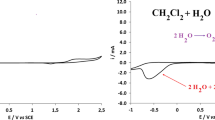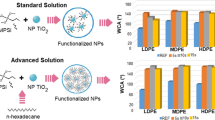Abstract
Highly hydrophobic properties with water adhesion (parahydrophobic properties) are obtained by electrodeposition of poly(3,4-propylenedioxythiophene) containing two alkoxy groups of various length (three to six). The depositions are performed by cyclic voltammetry with different deposition scans to obtain highly adherent and homogeneous films. The capacity to obtain highly hydrophobic properties is the highest with the shortest alkyl chains even if the monomer is intrinsically hydrophilic. This is due to the growth of nanofibers forming a highly porous film, favoring the Cassie-Baxter state but with a high water penetration inside the surface roughness. These coatings could be used in anti-bioadhesion for which it is important to have surface structures of size lower than that of bacteria.







Similar content being viewed by others
References
Darmanin T, Guittard F (2014) Recent advances in the potential applications of bioinspired superhydrophobic materials. J Mater Chem A 2:16319–16359
Su C (2009) Highly hydrophobic and oleophilic foam for selective absorption. Appl Surf Sci 256:1413–1418
Chen M, Jiang W, Wang F, Shen P, Ma P, Gu J, Mao J, Li F (2013) Synthesis of highly hydrophobic floating magnetic polymer nanocomposites for the removal of oils from water surface. Appl Surf Sci 286:249–256
Novio F, Ruiz-Molin D (2014) Hydrophobic coordination polymer nanoparticles and application for oil–water separation. RSC Adv 4:15293–15296
Peng M, Li H, Wu L, Zheng Q, Chen Y, Gu W (2005) Porous poly(vinylidene fluoride) membrane with highly hydrophobic surface. J Appl Polym Sci 1358–1363
Padial NM, Quartapelle Procopio E, Montoro C, López E, Oltra JE, Colombo V, Maspero A, Masciocchi N, Galli S, Senkovska I, Kaskel S, Barea E, Navarro JAR (2013) Highly hydrophobic isoreticular porous metal–organic frameworks for the capture of harmful volatile organic compounds. Angew Chem Int Ed 52:8290–8294
Lassen B, Holmberg K, Brink C, Carlén A, Olsson J (1994) Binding of salivary proteins and oral bacteria to hydrophobic and hydrophilic surfaces in vivo and in vitro. Colloid Polym J 272:1143–1150
Laga R, Koňák C, Šubr V, Ulbrich K (2007) Coating of nanoparticles bearing amino groups on the surface with hydrophilic HPMA-based polymers. Colloid Polym J 285:1509–1514
Bhatt S, Pulpytel J, Ceccone G, Lisboa P, Rossi F, Kumar V, Arefi-Khonsari F (2011) Nanostructure protein repellant amphiphilic copolymer coatings with optimized surface energy by inductively excited low pressure plasma. Langmuir 27:14570–14580
Pérez-Roldan MJ, Parracino A, Ceccone G, Colpo P, Rossi F (2014) Interactions of serum derived proteins with sub-micrometer structured surfaces. Plasma Process Polym 11:577–587
Bellanger H, Darmanin T, Taffin de Givenchy E, Guittard F (2014) Chemical and physical pathways for the preparation of superoleophobic surfaces and related wetting theories. Chem Rev 114:2694–2716
Wenzel RN (1936) Resistance of solid surfaces to wetting by water. Ind Eng Chem 28:988–994
Cassie ABD, Baxter S (1944) Wettability of porous surfaces. Trans Faraday Soc 40:546–551
Darmanin T, Guittard F (2014) Wettability of conducting polymers: from superhydrophilicity to superoleophobicity. Prog Polym Sci 39:656–682
Long Y-Z, Li M-M, Gu C, Wan M, Duvail J-L, Liu Z, Fan Z (2011) Recent advances in synthesis, physical properties and applications of conducting polymer nanotubes and nanofibers. Prog Polym Sci 36:1415–1442
Li C, Bai H, Shi G (2009) Conducting polymer nanomaterials: electrosynthesis and applications. Chem Soc Rev 38:2397–2409
Lin P, Yan F, Helen HLW (2009) Improvement of the tunable wettability property of poly(3-alkylthiophene) films. Langmuir 25:7465–7470
Doebbelin M, Tena-Zaera R, Marcilla R, Iturri J, Moya S, Pomposo JA, Mecerreyes D (2009) Multiresponsive PEDOT–ionic liquid materials for the design of surfaces with switchable wettability. Adv Funct Mater 19:3326–3333
Khedkar SP, Radhakrishnan S (1997) Application of dip-coating process for depositing conducting polypyrrole films. Thin Solid Films 303:167–172
Dong Q, Zhou Y, Pei J, Liu Z, Li Y, Yao S, Zhang J, Tian W (2010) All-spin-coating vacuum-free processed semi-transparent inverted polymer solar cells with PEDOT:PSS anode and PAH-D interfacial layer. Org Electron 11:1327–1331
McCarthy JE, Hanley CA, Brennan LJ, Lambertini VG, Gun’ko YK (2014) Fabrication of highly transparent and conducting PEDOT:PSS films using a formic acid treatment. J Mater Chem C 2:764–770
Zhang Z, Liang Y, Liang P, Li C, Fang S (2011) Protein adsorption materials based on conducting polymers: polypyrrole modified with ω‐(N‐pyrrolyl)‐octylthiol. Polym Int 60:703–710
Gabriel S, Cécius M, Fleury-Frenette K, Cossement D, Hecq M, Ruth N, Jérôme R, Jérôme C (2007) Synthesis of adherent hydrophilic polypyrrole coatings onto (semi)conducting surfaces. Chem Mater 19:2364–2371
Im SG, Kusters D, Choi W, Baxamusa SH, van de Sanden MCM, Gleason KK (2008) Conformal coverage of poly(3,4-ethylenedioxythiophene) films with tunable nanoporosity via oxidative chemical vapor deposition. ACS Nano 2:1959–1967
Taleb S, Darmanin T, Guittard F (2014) Elaboration of voltage and ion exchange stimuli-responsive conducting polymers with selective switchable liquid-repellency. ACS Appl Mater Interfaces 6:7953–7960
Yan H, Kurogi K, Mayama H, Tsujii K (2005) Environmentally stable super water-repellent poly(alkylpyrrole) films. Angew Chem Int Ed 44:3453–3456
Darmanin T, Guittard F (2014) Wettability of poly(3-alkyl-3,4-propylenedioxythiophene) fibrous structures forming nanoporous, microporous or micro/nanostructured networks. Mater Chem Phys 146:6–11
Luo S-C, Sekine J, Zhu B, Zhao H, Nakao A, H-h Y (2012) Polydioxythiophene nanodots, nonowires, nano-networks, and tubular structures: the effect of functional groups and temperature in template-free electropolymerization. ACS Nano 6:3018–3026
El-Maiss J, Darmanin T, Taffin de Givenchy E, Amigoni S, Eastoe J, Sagisaka M, Guittard F (2014) Superhydrophobic surfaces with low and high adhesion made from mixed (hydrocarbon and fluorocarbon) 3,4-propylenedioxythiophene monomers. J Polym Sci Part B Polym Phys 52:782–788
Mortier C, Darmanin T, Guittard F (2014) The major influences of substituent size and position of 3,4-propylenedioxythiophene on the formation of highly hydrophobic nanofibers. ChemPlusChem 79:1434–1439. doi:10.1002/cplu.201402187R1
Darmanin T, Mortier C, Guittard F (2014) One-pot process to control the elaboration of non-wetting nanofibers. Adv Mater Interfaces 1:1300094/1–1300094/6
Poverenov E, Li M, Bitler A, Bendikov M (2010) Major effect of electropolymerization solvent on morphology and electrochromic properties of PEDOT films. Chem Mater 22:4019–4025
Reeves BD, Grenier CRG, Argun AA, Cirpan A, McCarley TD, Reynolds JR (2004) Spray coatable electrochromic dioxythiophene polymers with high coloration efficiencies. Macromolecules 37:7559–7569
Galand EM, Kim Y-G, Mwaura JK, Jones AG, McCarley TD, Shrotriya V, Yang Y, Reynolds JR (2006) Optimization of narrow band-gap propylenedioxythiophene: cyanovinylene copolymers for optoelectronic applications. Macromolecules 39:9132–9142
Reeves BD, Unur E, Ananthakrishnan N, Reynolds JR (2007) Defunctionalization of ester-substituted electrochromic dioxythiophene polymers. Macromolecules 40:5344–5352
Zhao H, Liu C-Y, Luo S-C, Zhu B, Wang T-H, Hsu H-F, H-h Y (2012) Facile syntheses of dioxythiophene-based conjugated polymers by direct C−H arylation. Macromolecules 45:7783–7790
Park H-S, Ko S-J, Park J-S, Kim JY, Song H-K (2013) Redox-active charge carriers of conducting polymers as a tuner of conductivity and its potential window. Sci Rep 3:2454
Diaz AF, Crowley J, Bargon J, Gardini GP, Torrance JB (1981) Electrooxidation of aromatic oligomers and conducting polymers. J Electroanal Chem 121:355–361
Li M, Sheynin Y, Patra A, Bendikov M (2009) Tuning the electrochromic properties of poly(alkyl-3,4-ethylenedioxyselenophenes) having high contrast ratio and coloration efficiency. Chem Mater 21:2482–2488
Beaujuge PM, Reynolds JR (2010) Color control in π-conjugated organic polymers for use in electrochromic devices. Chem Rev 110:268–320
Patra A, Bendikov M, Chand S (2014) Poly(3,4-ethylenedioxyselenophene) and its derivatives: novel organic electronic materials. Acc Chem Res 47:1465–1474
Young T (1805) An essay on the cohesion of fluids. Phil Trans R Soc London 95:65–87
Marmur A (2013) Superhydrophobic and superhygrophobic surfaces: from understanding non-wettability to design considerations. Soft Matter 9:7900–7904
Marmur A (2008) From hygrophilic to superhygrophobic: theoretical conditions for making high-contact-angle surfaces from low-contact-angle materials. Langmuir 24:7573–7579
Marmur A (2012) Hydro- hygro- oleo- omni-phobic? Terminology of wettability classification. Soft Matter 8:6867–6870
Acknowledgments
The group thanks Jean-Pierre Laugier (CCMA, Université Nice Sophia Antipolis) for the SEM analyses. This project was supported by JSPS [KAKENHI, Grant-in-Aid for Young Scientists (A), No. 23685034], RCUK [through EPSRC EP/K020676/1], and ANR-13-G8ME-0003 under the G8 Research Councils Initiative on Multilateral Research Funding—G8-2012.
Author information
Authors and Affiliations
Corresponding author
Rights and permissions
About this article
Cite this article
Lamy, M., Darmanin, T. & Guittard, F. Highly hydrophobic films with high water adhesion by electrodeposition of poly(3,4-propylenedioxythiophene) containing two alkoxy groups. Colloid Polym Sci 293, 933–940 (2015). https://doi.org/10.1007/s00396-014-3451-1
Received:
Revised:
Accepted:
Published:
Issue Date:
DOI: https://doi.org/10.1007/s00396-014-3451-1




